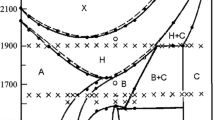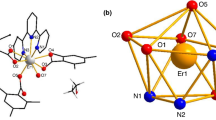Abstract
The complexes of yttrium and heavy lanthanides with 2,4-dimethoxybenzoic acid of the formula: Ln(C9H9O4)3×nH2O, where Ln=Tb(III), Dy(III), Ho(III), Er(III), Tm(III), Yb(III), Lu(III) and Y(III), n=2 for Tb(III), Dy(III), Ho(III), Er(III), Tm(III) and Y(III), and n=0 for Yb(III) and Lu(III), have been synthesized and characterized by elemental analysis, IR spectroscopy, themogravimetric studies, as well as X–ray and magnetic susceptibility measurements. The complexes have a colour typical of Ln 3+ salts (Tb, Dy, Tm, Yb, Lu, Y – white, Ho – cream, Er – pink). The carboxylate group in these complexes is a bidentate, chelating ligand. The compounds form crystals of various symmetry. 2,4-Dimethoxybenzoates of Yb(III) and Lu(III) are isostructural. 2,4-Dimethoxybenzoates of yttrium and heavy lanthanides decompose in various ways on heating in air to 1173 K. The hydrated complexes first lose water to form anhydrous salts and then decompose to the oxides of respective metals. The ytterbium and lutetium 2,4-dimethoxybenzoates decompose in one step to form Yb2O3 and Lu2O3.
The solubilities of the 2,4-dimethoxybenzoates of yttrium and heavy lanthanides in water and ethanol at 293 K are of the order of: 10–3 and 10–3 –10–2 mol dm–3, respectively. The magnetic moments for the complexes were determined over the range of 77–298 K. They obey the Curie–Weiss law. The results show that there is no influence of the ligand field on the 4f electrons of lanthanide ions.
Similar content being viewed by others
References
V. V. Zelentsov, Zh. Neorg. Khim, 13 (1968) 591.
Gmelin Handbook of Inorganic Chemistry, Springer-Verlag, Berlin 1984.
W. Ferenc and A. Walków-Dziewulska, J. Serb. Chem. Soc., 65 (2000) 27.
W. W. Wendlandt and J. A. Hoiberg, Anal. Chim. Acta, 29 (1963) 539.
Beilsteins Handbuch der organishen Chemie, Springer-Verlag, Berlin 1971.
D. R. Ellwood and K. Hitesh, Pharmacopeia, 98 (1999) 15.
Z. Marczenko, Spektrofotometryczne oznaczenie pierwiastków, PWN, Warszawa 1979.
Z. Marczenko and M. Balcerzak, Spektrofotometryczne metody w analizie nieorganicznej, PWN, Warszawa 1998.
B. N. Figgs and R. S. Nyholm, J. Chem. Soc., (1958) 4190.
E. König, Magnetic Properties of Coordination and Organometallic Transition Metal Compounds, Springer-Verlag, Berlin 1966.
K. Nakamoto, Infrared and Raman Spectra of Inorganic and Coordination Compounds, John Wiley and Sons, Toronto 1968.
K. Nakamoto and P. J. McCarthy, Spectroscopy and Structure of Metal Chelate Compounds, John Wiley and Sons, New York 1968.
R. C. Mehrotra and R. Bohra, Metal Carboxylates, Academic Press, London 1983.
A. K. Brisdon, Inorganic Spectroscopic Methods, Oxford University Press, Oxford 1998.
L. M. Harwood and T. D. W Claridge, Introduction to Organic Spectroscopy, Oxford University Press, Oxford 1999.
L. J. Bellamy, The Infrared Spectra of Complex Molecules, Chapman and Hill, London 1975.
K. Burger, Coordination Chemistry: Experimental Methods, Akadémiai Kiadó, Budapest 1973.
B. S. Manhas and A. K. Trikha, J. Indian Chem. Soc., 59 (1982) 315.
E. Lagiewka and Z. Bojarski, Rentgenowska analiza strukturalna, PWN, Warszawa 1988.
P. Pascal, Noveau Traité de Chimie Minérale, Maon et cie, Paris 1959.
M. Van Meerche and J. Feneau-Dupont, Introduction la Crystallographie et la Chimie Structrale, OYEZ Leuven, Paris 1976.
D. N. Todor, Thermal Analysis of Minerals, Abacus Press, Tunbridge Wells, Kent 1976.
F. Paulik, Special Trends in Thermal Analysis, Wiley, Chichester 1995.
A. V. Nikolaev, V. A. Logvienko and L. J. Myachina, Thermal Analysis, Vol. 2, Academic Press, New York 1989.
B. Singh, B. V. Agarwala, P. L. Mourya and A. K. Dey, J. Indian Chem. Soc., 59 (1992) 1130.
Ch. A. Cherchas and T. P. Jezierskaja, Izv. Akad. Nauk SSSR, 1 (1977) 45.
C. J. O'Conner, Progress in Inorganic Chemistry, Vol. 29, Wiley, New York 1982.
C. Benelli, A. Caneschi, D. Gatteschi, J. Laugier and P. Rey, Angew. Chem., 26 (1989) 913.
C. Benelli, A. Caneschi, D. Gatteschi, J. Laugier and L. Pardi, Inorg. Chem., 28 (1989) 275.
C. Benelli, A. Caneschi, D. Gatteschi, J. Laugier, L. Pardi and P. Rey, Inorg. Chem., 28 (1989) 320.
S. P. Sinha, Systematics and Properties of the Lanthanides, Reidel, Dordrecht 1983.
D. J. Karraker, J. Chem. Educ., 47 (1970) 424.
Author information
Authors and Affiliations
Rights and permissions
About this article
Cite this article
Ferenc, W., Walków-Dziewulska, A. Thermal and Spectral Features of Yttrium and Heavy Lanthanide Complexes with 2,4-dimethoxybenzoic Acid. Journal of Thermal Analysis and Calorimetry 63, 865–877 (2001). https://doi.org/10.1023/A:1010120911658
Issue Date:
DOI: https://doi.org/10.1023/A:1010120911658




